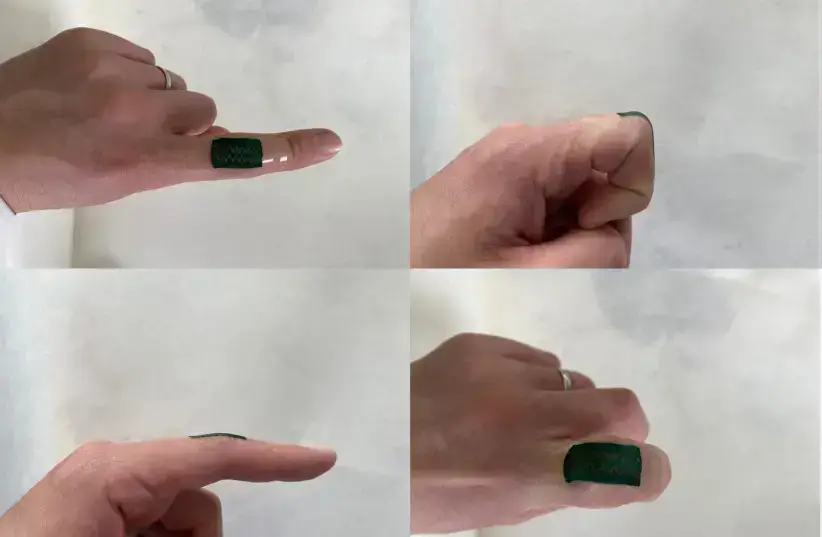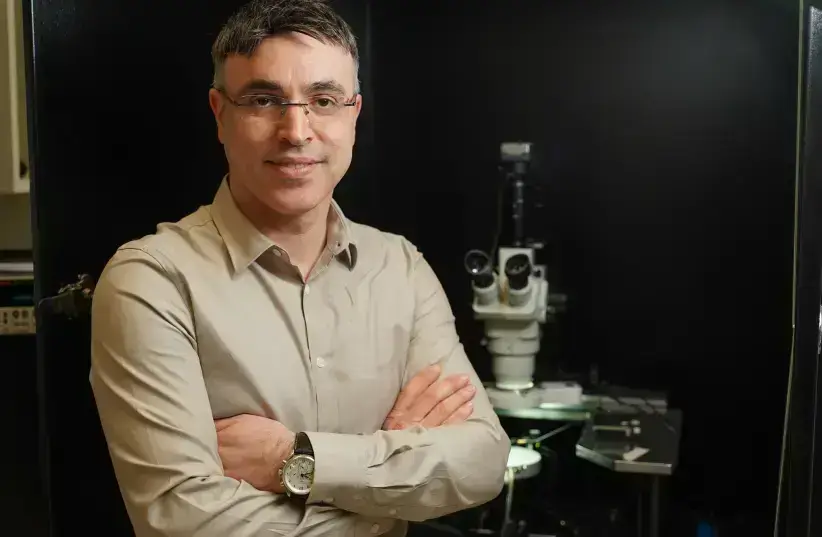
Researchers at the Technion have developed a highly stretchable electronic material and a wearable sensor capable of identifying precise bending and twisting motions.
Scientists at the Technion-Israel Institute of Technology have produced a highly stretchable electronic material and a wearable sensor capable of identifying precise bending and twisting motions.
Essentially, it is an electronic skin.
The development will be able to help identify ailments and disease, for example, the early onset of Parkinson’s, or help amputees adapt to prosthetics, the developers have said.
It recognizes the range of movements that human joints normally makes with the precision of up to half a degree. This breakthrough is the result of collaborative work, headed by Professor Hossam Haick from the Wolfson Faculty of Chemical Engineering.
It was recently published in Advanced Materials, a peer-reviewed journal.
Professor Haick’s lab focuses on wearable devices. Wearable motion sensors can currently recognize bending movement, but not twisting. Sensors that recognize twisting are large and cumbersome.
Ph.D candidate Yehu David Horev and postdoctoral fellow Dr. Arnab Maity have found a way to overcome this problem. Horev found a way to form a composite material that is both usable as a sensor and is flexible, stretchable, breathable, biocompatible, and does not change its electrical properties when stretched.
Dr. Maity was able to solve the mathematics of analysing the received signal.

The novel sensor is breathable, durable and lightweight, allowing it to be worn by humans for long periods of time.
“This sensor has many possible applications,” Prof. Haick stated.
“It can be used in early disease diagnosis, alerting of breathing alterations, and motor system disorders such as Parkinson’s disease. It can be used to assist patients’ motor recovery and be integrated into prosthetic limbs. In robotics, the feedback it provides is crucial for precise motion. In industrial uses, such sensors are necessary in monitoring systems.”
TECHNION SCIENTISTS CREATED A WEARABLE MOTION SENSOR CAPABLE OF IDENTIFYING BENDING AND TWISTING
One doesn’t pay much attention to sensors, but they are omnipresent in modern life. A sensor is a device that responds to a physical stimulus such as heat, light, sound, pressure, magnetism or a particular motion and transmits a resulting impulse as for measurement or operating a control. It measures physical input from its environment and converts it into data that can be interpreted by either a human or a machine.
The most frequently used types of sensors are classified according to hat they react to – electric current or magnetic or radio sensors, humidity, fluid velocity or flow, pressure, temperature sensors, proximity sensors, optical sensors or position sensors.
Sensors are used in everyday objects such as touch-sensitive elevator buttons, lamps that brighten or dim by touching the base, along with innumerable applications of which most people are unaware.
Aside from home use, sensor applications include manufacturing, medicine, machinery, planes and aerospace, vehicles, robotics and many other aspects of life.
Wearable strain sensors have been attracting special attention in the detection of human posture and activity, as well as for the assessment of physical rehabilitation and kinematic, but it is a challenge to fabricate stretchable and comfortable-to-wear permeable strain sensors that can provide highly accurate and continuous motion recording while exerting minimal constraints and maintaining low interference with the body.
Now, scientists at the Technion-Israel Institute of Technology in Haifa have created a wearable motion sensor capable of identifying bending and twisting. Made from a highly stretchable electronic material, it is essentially an electronic skin capable of recognizing the range of movement human joints normally make, with up to half a degree precision.
This breakthrough is the result of collaborative work among researchers from different fields in the Laboratory for Nanomaterial-Based Devices, headed by Prof. Hossam Haick from the Wolfson Faculty of Chemical Engineering. It was recently published in Advanced Materials under the title “Stretchable and Highly Permeable Nanofibrous Sensors for Detecting Complex Human Body Motion”
and was featured on the journal’s cover.
The new sensor has many possible applications,” said Haick. “It can be used in early disease diagnosis, alerting of breathing alterations, and motor system disorders such as Parkinson’s disease. It can also assist patients in their motor recovery and be integrated into prosthetic limbs. In robotics, the feedback it provides is crucial for precise motion. In industrial uses, such sensors are necessary in monitoring systems, putting them at the core of the Fourth Industrial Revolution.”
This breakthrough is the result of collaborative work between researchers from different fields in the Laboratory for Nanomaterial-Based Devices, which Haick heads.
At present, existing wearable motion sensors can recognize bending movement, but not twisting. Existing twisting sensors, on the other hand, are large and cumbersome and cannot be worn.. This problem was overcome by doctoral candidate Yehu David Horev and postdoctoral fellow Dr. Arnab Maity.
Horev found a way to form a composite material that was both conductive – and thus, usable as a sensor – and flexible, stretchable, breathable and biocompatible, I also did not change its electrical properties when stretched.
Maity then solved the mathematics of analyzing the received signal, creating an algorithm capable of mapping bending and twisting motion – the nature of the movement, its speed and its angle. The novel sensor is breathable, durable and lightweight, making it possible to be worn on the human body for prolonged periods.
“Electrically conductive polymers are usually quite brittle,” explained Yehu about the challenge the group had overcome. “To solve this, we created a composite material that is a little like fabric. The individual polymer ‘threads’ cannot withstand the strain on the material, but their movement relative to each other lets it stretch without breaking. It is not too different from what lends stretch to T-shirts. This allows the conductive polymer withstand extreme mechanical conditions without losing its electrical properties.”
What makes this achievement more important is that the materials the group used are very inexpensive, resulting in a cheap sensor. “If we make a device that is very expensive, only a small number of institutions in the Western world could afford to use it. We want the technological advances we achieve to benefit everyone, regardless of their geographic location and socioeconomic status,” said Haick. True to his word, among the laboratory’s other projects is a tuberculosis-diagnosing sticker patch, which is sorely needed in developing countries.
Haick is an expert in the field of nanotechnology and non-invasive disease diagnosis who earned his doctorate from the Technion in 2002. After graduation, he completed two postdoctoral fellowships – first at the Weizmann Institute of Science in Rehovot and then at California Institute of Technology. He returned to the Technion at the end of 2006 as an assistant professor, becoming a full professor in 2011.
He has published more than 220 publications in top-level journals in the field of nanotechnology, advanced/applied materials/chemistry and medicine, and technologies he and his team developed have led to the production of more than 42 patents and patent applications – many of which have been licensed to six international companies.
An Arab-Israeli scientist and engineer, Haick is a pioneer known for inventing the Nano Artificial Nose for detection of disease from exhaled breath. He was included in more than 80 top-rank listings worldwide, including the “MIT Technology Review” list of 35 leading young scientists in the world, the “50 Sharpest Israeli Minds” and the world’s top-100 influential innovators in the Digital Technology by Nominet Trust in London.
